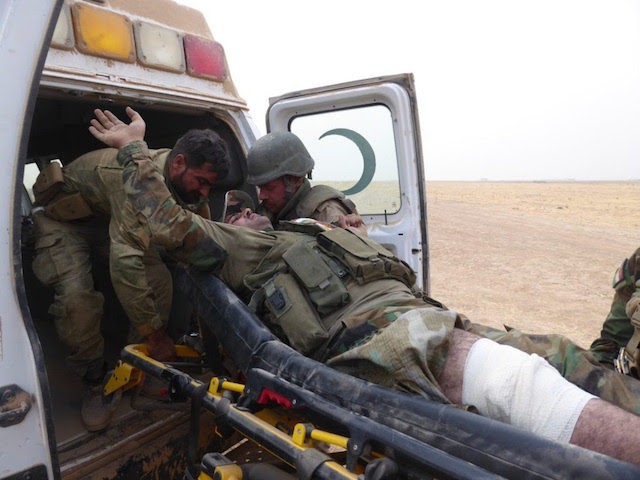SHURA, Iraq (AP) — When airstrikes and artillery began rocking the village of Shura south of Mosul, Barah Hussein Abed and his family moved into a hallway in the center of their home to wait out the barrage. More than two years of extremist rule and weeks of clashes between the Islamic State group and Iraqi forces have turned Abed’s house into a bunker, like the dwellings of many of their neighbors.
“It’s like living in a prison,” he said.
Months after IS swept into Shura, the militants killed Abed’s brother because he was a police officer. Last week, another relative died in an airstrike intended to liberate the village.
Abed and his wife, Suriyah, hung thick curtains in their windows to prevent fighters from seeing inside. As shelling and airstrikes broke window panes in their living room, they replaced them with wooden and plastic panels. All the while, Iraqi advances in the south initially made food more expensive, then unavailable altogether.
“If (the Iraqi forces) didn’t come today or tomorrow, we would have died,” Suriyah said.
While the fight on Mosul’s eastern front has moved at a brisk, steady pace since the offensive formally began October 17, the ground assault to the south has been a grinding slog.
The Nineveh desert south of Mosul along the Tigris River valley is dotted with dozens of populated villages that have repeatedly slowed down Iraqi forces. In the three months since the military began moving its forces into the valley and retook a nearby air base, the southern front line has moved only 24 kilometers (15 miles).
The country’s elite special forces — the most experienced and professional of Iraq’s ground troops — have largely been moving through villages east of Mosul that were long emptied of civilians. With fewer chances of casualties, heavy airstrikes by the US-led coalition and Iraqi artillery have helped clear territory and speed progress.
The operation that pushed IS out of Shura — a village of fewer than 1,000 houses about 35 kilometers (22 miles) south of Mosul — required days of preparation and about 2,000 Iraqi army and federal police to take on no more than 50 militants.
The methodical assault was intended to minimize casualties among Iraq’s armed forces — a military force still recovering from the catastrophic defeat suffered in Mosul’s fall in 2014. But it also has meant that humanitarian conditions in IS-held territory have deteriorated and are almost like a siege, putting civilians at risk.
The region has long been a hub for insurgents, their finance networks and anti-government sentiment following the US-led overthrow of Saddam Hussein in 2003. When US forces battled al-Qaeda in Iraq — the predecessor to the Islamic State group — on these same desert plains, the fighters repeatedly fell back into Mosul and nearby villages to regroup.
On the outskirts of the Shura operation, federal police Brig. Gen. Fakher Ali watched the progress of the offensive on a tablet displaying a satellite map, with about two dozen red dots marking suspected IS positions that were hit by airstrikes or artillery. When his forces are fired on by a suspected sniper, they halt their convoy and wait for artillery to clear the position, he said.
In the days before the assault, Iraqi forces watched via coalition surveillance drones as hundreds of IS fighters withdrew northward from Shura, taking thousands of civilians with them, said federal police Lt. Col. Hussein Nazim.
“Each time we approach, they almost all flee,” he said, explaining that the militants leave behind only a small unit instructed to fight to the death.
The majority of fighters escape before the slow-moving Iraqi assault begins, he said, melting back into residential areas still under militant control and increasingly using civilian captives as human shields.
“This isn’t something where you can say, ‘if we move slowly, air-power and artillery power are going to deal with the issues,’ because it also gives ISIS time to consolidate,” said Anthony Cordesman, a former adviser to the US-led training effort of Iraqi forces and currently a security analyst with the Washington-based Center for Strategic and International Studies. ISIS is another acronym for the Islamic State group.
Having the ability to pull back and regroup repeatedly is allowing a relatively small number of IS fighters to punch above their weight and delay overwhelming numbers of Iraqi troops, Cordesman said.
In the wake of Iraqi advances, local tribal and militia fighters have largely taken over security in recently “liberated” Nineveh province as Iraq’s military is increasingly stretched thin. Largely operating in a power vacuum, the local forces have already been accused of abusing civilians fleeing IS-held territory.
Gen. David Petraeus, who commanded US forces in Mosul in 2003, relied heavily on local forces to secure Nineveh province.
“As quickly as we could, we consolidated those forces and put them underneath either the police or the military,” he said.
But the situation was entirely different back then, because he had some 20,000 highly trained US troops at his disposal, Petraeus added.
“I was sort of the sheikh of the strongest tribe,” he said, “Today, there’s no comparable figure in Nineveh province.”
A few kilometers (miles) back from the front-line fighting south of Mosul, a group of Iraqi soldiers played patriotic music in their Humvees, snapped photos with mobile phones and cheered on the artillery blasts rocking a cluster of dusty, low houses on the horizon.
Standing to the side of the noisy onlookers, Iraqi army Sgt. Rakan Nasser’s eyes welled with tears. His wife and young children are trapped in Mosul, and as the fight pushed closer, his worries grew for their safety.
Nasser said he’s able to talk to them every few weeks, depending on cellphone coverage.
“They just say, “we’re waiting for you to reach us,”” he said, “I tell them we are very near, but honestly, we are far.”

COMMENTS
Please let us know if you're having issues with commenting.